With near-record heat reaching deep into September throughout much of the country, it might be hard to remember that winter is around the corner. But cooler temperatures are coming - eventually - and GRIGG wants to make that transition and emergence in spring as seamless as possible.
 Grigg, in cooperation with the universities of Massachusetts and Georgia, recently presented a three-day series of webinars covering winter prep on golf courses for cool- and warm-season turfgrasses.
Grigg, in cooperation with the universities of Massachusetts and Georgia, recently presented a three-day series of webinars covering winter prep on golf courses for cool- and warm-season turfgrasses.Held Sept. 26-28, the three-day seminar included presentations by Michelle DaCosta, Ph.D., associate professor of turfgrass physiology at UMass; Gordon Kauffman, Ph.D., turf and ornamental technical manager for Brandt, the parent company of Grigg; and Gerald Henry, Ph.D., associate professor of turfgrass environmental science at the University of Georgia.
All three are available for on-demand playback by clicking here.
DaCosta has published several pieces of research on the effects of winter conditions on annual bluegrass and creeping bentgrass. Her presentation entitled "Maximizing cool-season turfgrass physiology and management for winter survival" focused on a practical overview of cool-season turfgrass physiology and management strategies as related to low temperature preconditioning and winter survival.
Topics discussed include the major causes for winter injury in northern climates, physiological mechanisms aiding in turfgrass freezing tolerance, as well how environmental conditions and management practices interact with turfgrass physiology to impact winter survival.
She also addressed best management practices to help minimize winter injury and promote turf recovery in the spring.
Part II in the series was Kauffman's "Cultural strategies for autumn and cool-season turfgrasses."
His focus was on fertilization and additional cultural practices that can lead to improved turf vigor, winter survival, and spring green up, as well as nutrient requirements, their source, and timing and method of application.
That presentation also covers topics such as how carefully planned fall fertilization, mechanical cultivation and disease control strategies can impact turfgrass growth and vigor in late fall and winter.
 The series concluded with Henry's presentation "Preparing warm-season turfgrasses for cold stress."
The series concluded with Henry's presentation "Preparing warm-season turfgrasses for cold stress."
Henry, who started the turf program at Texas Tech, came to UGA in 2012 after the retirement of Keith Karnok, and is an associate professor of turfgrass science with an emphasis on plant, pest and environmental interactions. His research interests include a wide range of subjects, such as physiology, ecology, weed science, fertility and management.
His winter prep presentation addressed low-temperature stress and proper management strategies to enhance warm-season turfgrass acclimation to winter conditions.
Specific topics include impact of cultural practices on the onset of turfgrass dormancy, symptomatology of freezing injury, genetic variability in freezing tolerance and microclimate influences on injury severity. He also discussed best management practices for the reduction of winter injury and encouragement of turfgrass recovery/spring green-up.
All TurfNet Webinars are sponsored by Grigg and BASF and live broadcasts are free for TurfNet members and non-members. All are recorded and available on-demand for TurfNet members. Select archived webinars, including the winter prep series, are available for non-members, as well.

